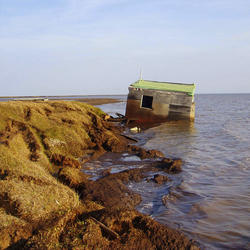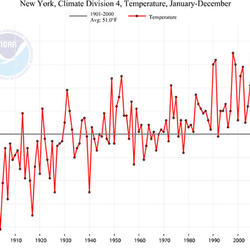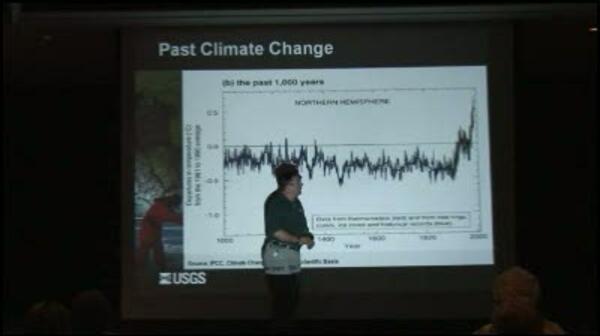USGS scientist Louis Sass assesses an on-glacier weather station on the Kahiltna Glacier in Denali National Park, Alaska. This weather station is located at Kahiltna Base Camp, where climbers attempting to summit Denali begin their ascent. Sultana (Mt. Foraker) is visible in the background.
What is the difference between weather and climate change?
Weather refers to short term atmospheric conditions while climate is the weather of a specific region averaged over a long period of time. Climate change refers to long-term changes.
Related
Could a large Yellowstone eruption significantly change the climate?
Do volcanoes affect weather?
Is there earthquake weather?
What are the long-term effects of climate change?
How can climate change affect natural disasters?
How do changes in climate and land use relate to one another?
How do we know the climate is changing?
Why is climate change happening and what are the causes?
What is the difference between global warming and climate change?
What are some of the signs of climate change?
Does the USGS monitor global warming?
USGS scientist Louis Sass assesses an on-glacier weather station on the Kahiltna Glacier in Denali National Park, Alaska. This weather station is located at Kahiltna Base Camp, where climbers attempting to summit Denali begin their ascent. Sultana (Mt. Foraker) is visible in the background.
A scientist is holding the cable top at a recently relocated site for permafrost ground temperature monitoring in Utqiagvik, Alaska (part of USGS research at the Naval Arctic Research Laboratory from the 1950s to 1970s).
A scientist is holding the cable top at a recently relocated site for permafrost ground temperature monitoring in Utqiagvik, Alaska (part of USGS research at the Naval Arctic Research Laboratory from the 1950s to 1970s).

Climate change data from the USGS National Climate Change Viewer tool is shown by US state and county for the contiguous US.
Climate change data from the USGS National Climate Change Viewer tool is shown by US state and county for the contiguous US.
Climate Change Refugia (noun): Areas buffered from climate change that enable the continued persistence of plants and animals.
Climate Change Refugia (noun): Areas buffered from climate change that enable the continued persistence of plants and animals.
A scientist checks data collection on multiple sensors at the Gulkana Glacier weather station where snow blankets the glacier surface.
A scientist checks data collection on multiple sensors at the Gulkana Glacier weather station where snow blankets the glacier surface.

USGS scientist Erich Peitzsch does repair on the Sperry Weather Station in Glacier National Park. Information gathered by the USGS managed Sperry Weather Station are being used by regional fire managers to forecast fire weather and future fire behavior during the 2017 fire season.
USGS scientist Erich Peitzsch does repair on the Sperry Weather Station in Glacier National Park. Information gathered by the USGS managed Sperry Weather Station are being used by regional fire managers to forecast fire weather and future fire behavior during the 2017 fire season.

USGS staff ski to and from the Garden Wall weather station in Glacier National Park (elev. 7400 feet) to complete maintenance and examine the snowpack for avalanche research.
USGS staff ski to and from the Garden Wall weather station in Glacier National Park (elev. 7400 feet) to complete maintenance and examine the snowpack for avalanche research.
NEXRAD (NEXt generation RADar) is also known as Weather Surveillance Radar, 1988 Doppler (WSR-88D). Pictured is the tower that houses the antennae inside the radome (white sphere).
NEXRAD (NEXt generation RADar) is also known as Weather Surveillance Radar, 1988 Doppler (WSR-88D). Pictured is the tower that houses the antennae inside the radome (white sphere).
Climate change is an issue of increasing public concern because of its potential effects on land, water, and biological resources.
Climate change is an issue of increasing public concern because of its potential effects on land, water, and biological resources.
 USGS Public Lecture Series: Watching Nature's Clock: A Citizen-Scientist Effort to Track Seasonal Signs of Climate Change
USGS Public Lecture Series: Watching Nature's Clock: A Citizen-Scientist Effort to Track Seasonal Signs of Climate Change
USGS Public Lecture Series: Watching Nature's Clock: A Citizen-Scientist Effort to Track Seasonal Signs of Climate Change
linkA new USGS program, the USA National Phenology Network, is recruiting tens of thousands of volunteers to team up with scientists to help track the effects of climate on seasonal patterns of plant and animal behavior.
USGS Public Lecture Series: Watching Nature's Clock: A Citizen-Scientist Effort to Track Seasonal Signs of Climate Change
linkA new USGS program, the USA National Phenology Network, is recruiting tens of thousands of volunteers to team up with scientists to help track the effects of climate on seasonal patterns of plant and animal behavior.
Weather Station on Tern Island in the middle of Crump Lake protected by bird spikes.
Weather Station on Tern Island in the middle of Crump Lake protected by bird spikes.

Crumbling blocks of permafrost along the Beaufort Coast
Crumbling blocks of permafrost along the Beaufort Coast
Managing for tomorrow—A climate adaptation decision framework
Climate change and future water availability in the United States
U.S. Geological Survey National Groundwater Climate Response Network
Ecosystem vulnerability to climate change in the southeastern United States
Improved ground-based remote-sensing systems help monitor plant response to climate and other changes
Developing integrated methods to address complex resource and environmental issues
USGS Arctic Science Strategy
Climate change: evaluating your local and regional water resources
Changing Arctic ecosystems: sea ice decline, permafrost thaw, and benefits for geese
The U.S. Geological Survey Climate Geo Data Portal: an integrated broker for climate and geospatial data
DOI Climate Science Centers--Regional science to address management priorities
Why Study Paleoclimate?
Related
Could a large Yellowstone eruption significantly change the climate?
Do volcanoes affect weather?
Is there earthquake weather?
What are the long-term effects of climate change?
How can climate change affect natural disasters?
How do changes in climate and land use relate to one another?
How do we know the climate is changing?
Why is climate change happening and what are the causes?
What is the difference between global warming and climate change?
What are some of the signs of climate change?
Does the USGS monitor global warming?
USGS scientist Louis Sass assesses an on-glacier weather station on the Kahiltna Glacier in Denali National Park, Alaska. This weather station is located at Kahiltna Base Camp, where climbers attempting to summit Denali begin their ascent. Sultana (Mt. Foraker) is visible in the background.
USGS scientist Louis Sass assesses an on-glacier weather station on the Kahiltna Glacier in Denali National Park, Alaska. This weather station is located at Kahiltna Base Camp, where climbers attempting to summit Denali begin their ascent. Sultana (Mt. Foraker) is visible in the background.
A scientist is holding the cable top at a recently relocated site for permafrost ground temperature monitoring in Utqiagvik, Alaska (part of USGS research at the Naval Arctic Research Laboratory from the 1950s to 1970s).
A scientist is holding the cable top at a recently relocated site for permafrost ground temperature monitoring in Utqiagvik, Alaska (part of USGS research at the Naval Arctic Research Laboratory from the 1950s to 1970s).

Climate change data from the USGS National Climate Change Viewer tool is shown by US state and county for the contiguous US.
Climate change data from the USGS National Climate Change Viewer tool is shown by US state and county for the contiguous US.
Climate Change Refugia (noun): Areas buffered from climate change that enable the continued persistence of plants and animals.
Climate Change Refugia (noun): Areas buffered from climate change that enable the continued persistence of plants and animals.
A scientist checks data collection on multiple sensors at the Gulkana Glacier weather station where snow blankets the glacier surface.
A scientist checks data collection on multiple sensors at the Gulkana Glacier weather station where snow blankets the glacier surface.

USGS scientist Erich Peitzsch does repair on the Sperry Weather Station in Glacier National Park. Information gathered by the USGS managed Sperry Weather Station are being used by regional fire managers to forecast fire weather and future fire behavior during the 2017 fire season.
USGS scientist Erich Peitzsch does repair on the Sperry Weather Station in Glacier National Park. Information gathered by the USGS managed Sperry Weather Station are being used by regional fire managers to forecast fire weather and future fire behavior during the 2017 fire season.

USGS staff ski to and from the Garden Wall weather station in Glacier National Park (elev. 7400 feet) to complete maintenance and examine the snowpack for avalanche research.
USGS staff ski to and from the Garden Wall weather station in Glacier National Park (elev. 7400 feet) to complete maintenance and examine the snowpack for avalanche research.
NEXRAD (NEXt generation RADar) is also known as Weather Surveillance Radar, 1988 Doppler (WSR-88D). Pictured is the tower that houses the antennae inside the radome (white sphere).
NEXRAD (NEXt generation RADar) is also known as Weather Surveillance Radar, 1988 Doppler (WSR-88D). Pictured is the tower that houses the antennae inside the radome (white sphere).
Climate change is an issue of increasing public concern because of its potential effects on land, water, and biological resources.
Climate change is an issue of increasing public concern because of its potential effects on land, water, and biological resources.
 USGS Public Lecture Series: Watching Nature's Clock: A Citizen-Scientist Effort to Track Seasonal Signs of Climate Change
USGS Public Lecture Series: Watching Nature's Clock: A Citizen-Scientist Effort to Track Seasonal Signs of Climate Change
USGS Public Lecture Series: Watching Nature's Clock: A Citizen-Scientist Effort to Track Seasonal Signs of Climate Change
linkA new USGS program, the USA National Phenology Network, is recruiting tens of thousands of volunteers to team up with scientists to help track the effects of climate on seasonal patterns of plant and animal behavior.
USGS Public Lecture Series: Watching Nature's Clock: A Citizen-Scientist Effort to Track Seasonal Signs of Climate Change
linkA new USGS program, the USA National Phenology Network, is recruiting tens of thousands of volunteers to team up with scientists to help track the effects of climate on seasonal patterns of plant and animal behavior.
Weather Station on Tern Island in the middle of Crump Lake protected by bird spikes.
Weather Station on Tern Island in the middle of Crump Lake protected by bird spikes.

Crumbling blocks of permafrost along the Beaufort Coast
Crumbling blocks of permafrost along the Beaufort Coast



















